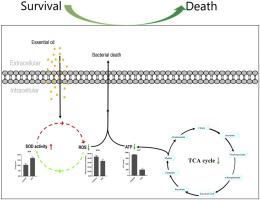Microbiological Research ( IF 6.7 ) Pub Date : 2020-09-25 , DOI: 10.1016/j.micres.2020.126608 Cailin Tang 1 , Jiali Chen 2 , Yang Zhou 2 , Ping Ding 3 , Guozhen He 3 , Lixia Zhang 4 , Zhimin Zhao 2 , Depo Yang 2

|
Amomum villosum Lour (A. villosum Lour) has medicinal properties and has been widely used in China for many years. Herein we aimed to investigate the antibacterial mechanism and the metabolome variation caused by A. villosum Lour essential oil (EO) in methicillin-resistant Staphylococcus aureus (MRSA). The metabolite profile of MRSA was acquired, and metabolic pathways were assessed for significant alterations caused upon treating bacterial cells with EO, the antibacterial mechanism of EO was further investigated in combination with multiple experiments. Metabolomics analysis revealed that 72 metabolites and 10 pathways were significantly affected. EO specifically disrupted amino acid metabolism and the tricarboxylic acid (TCA) cycle, and also inhibited adenosine triphosphate (ATP) and reactive oxygen species (ROS) synthesis. Furthermore, the activities of pivotal enzymes involved in the TCA cycle were suppressed. Increased ROS levels could decrease the sensitivity of MRSA to EO, improving the survival of EO-treated MRSA cells. Our data indicate that A. villosum Lour EO causes metabolic dysfunction in MRSA, leading to reduced ROS levels, disruption of the TCA cycle, inhibition of ATP synthesis, and suppression of the activities of key enzymes.



























 京公网安备 11010802027423号
京公网安备 11010802027423号